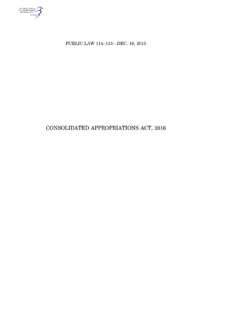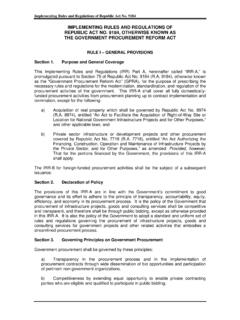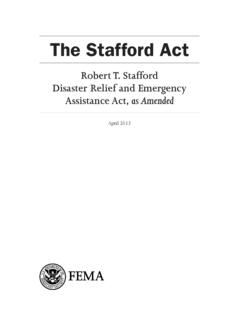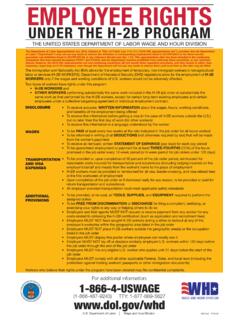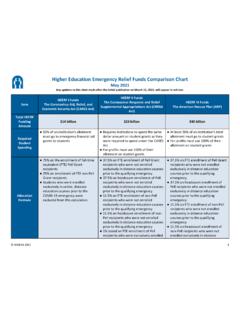Transcription of The Violence Against Women Act (VAWA): Historical Overview ...
1 The Violence Against Women Act (VAWA): Historical Overview , Funding, and Reauthorization Updated April 23, 2019 Congressional Research Service R45410 Congressional Research Service SUMMARY The Violence Against Women Act (VAWA): Historical Overview , Funding, and Reauthorization The Violence Against Women Act (VAWA; Title IV of 103-322) was originally enacted in 1994. It addressed congressional concerns about violent crime, and Violence Against Women in particular, in several ways. It allowed for enhanced sentencing of repeat federal sex offenders; mandated restitution to victims of specified federal sex offenses; and authorized grants to state, local, and tribal law enforcement entities to investigate and prosecute violent crimes Against Women , among other things. VAWA has been reauthorized three times since its original enactment. Most recently, Congress passed and President Obama signed the Violence Against Women Reauthorization Act of 2013 ( 113-4), which reauthorized most VAWA programs through FY2018, among other things.
2 The fundamental goals of VAWA are to prevent violent crime; respond to the needs of crime victims; learn more about crime; and change public attitudes through a collaborative effort by the criminal justice system, social service agencies, research organizations, schools, public health organizations, and private organizations. The federal government tries to achieve these goals primarily through federal grant programs that provide funding to state, tribal, territorial, and local governments; nonprofit organizations; and universities. VAWA programs generally address domestic Violence , sexual assault, dating Violence , and stalking crimes for which the risk of victimization is highest for Women although some VAWA programs address additional crimes. VAWA grant programs largely address the criminal justice system and community response to these crimes, but certain programs address prevention as well.
3 The Office on Violence Against Women (OVW) administers the majority of VAWA-authorized programs, while other federal agencies, including the Centers for Disease Control and Prevention (CDC) and the Office of Justice Programs (OJP), also manage VAWA programs. Since its creation in 1995 through FY2018, OVW has awarded more than $8 billion in grants and cooperative agreements to state, tribal, and local governments, nonprofit organizations, and universities. In FY2019, approximately $559 million was appropriated for VAWA-authorized programs administered by OVW, OJP, and CDC. While several extensions of authorization for VAWA were provided through FY2019 continuing appropriations , authorizations for appropriations for all VAWA programs have since expired. However, all VAWA programs funded in FY2018 have been funded in FY2019 (select programs at slightly higher levels), and thus far it appears that the expiration of authorizations has not impacted the continuing operation of VAWA programs.
4 The Administration has requested FY2020 funding for all VAWA-authorized programs funded in FY2019. There are several issues that Congress may consider in efforts to reauthorize VAWA. These include, but are not limited to, improvements to data collection on domestic Violence and stalking or the rape kit backlog; assessing the implementation and future direction of tribal jurisdiction over non-tribal members, including potentially adding new crimes under VAWA; new approaches for law enforcement in assisting victims; and enforcement of the federal prohibition on firearms for those convicted of a misdemeanor crime of domestic Violence and those who are subject to a domestic Violence protective order. Congress may also consider further changes to VAWA programs. In the 116th Congress, the House passed the Violence Against Women Reauthorization Act of 2019 ( 1585). Among other things, it would reauthorize funding for VAWA programs and authorize new programs; amend and add definitions used for VAWA programs; amend federal criminal law relating to firearms, custodial rape, and stalking; and expand tribal jurisdiction over certain crimes committed on tribal lands.
5 R45410 April 23, 2019 Lisa N. Sacco Analyst in Illicit Drugs and Crime Policy The Violence Against Women Act (VAWA) Congressional Research Service Contents Introduction .. 1 Origins of VAWA .. 1 Violence Against Women Act of 1994 .. 2 Investigations and Prosecutions .. 2 Grant Programs .. 3 Immigration Provisions .. 4 Other VAWA Requirements .. 4 Office on Violence Against Women .. 4 Categories of Crime Addressed through VAWA .. 5 Domestic Violence .. 6 Intimate Partner Homicide .. 6 Sexual Assault .. 7 Dating Violence .. 10 Stalking .. 10 Federal Programs Authorized by VAWA .. 12 FY2018 FY2019 appropriations .. 12 FY2020 appropriations .. 14 Past Reauthorizations and Changes to VAWA .. 15 2000 Reauthorization .. 15 2005 Reauthorization .. 16 2013 Reauthorization .. 16 Consolidation of Grant Programs .. 17 VAWA Grant Provisions .. 18 Accountability of Grantees.
6 19 Sexual Assault and Rape Kit Backlog .. 19 Trafficking in Persons .. 20 American Indian Tribes .. 20 Battered Nonimmigrants .. 21 Underserved Populations .. 21 Housing .. 21 Institutions of Higher Education (IHEs) .. 22 Other Changes .. 23 Rape Survivor Child Custody Act .. 23 Current Efforts to Reauthorize VAWA .. 23 Improvements to Data Collection .. 24 Tribal Jurisdiction .. 25 New Approaches for Law Enforcement .. 26 Domestic Violence and Federal Prohibition of Possession of Firearms .. 27 Other Changes to VAWA Programs .. 28 Figures Figure 1. Forcible Rapes Known to Police .. 8 Figure 2. Sexual Assault Victimizations Reported and Not Reported to Police .. 9 The Violence Against Women Act (VAWA) Congressional Research Service Figure 3. Estimated Number of Stalking Victims, Lifetime and 12-Month Period .. 11 Tables Table 1. FY2018 and FY2019 appropriations and Set-Asides for VAWA Programs.
7 12 Table A-1. Current VAWA-Authorized Programs Funded Under the Departments of Justice and Health and Human Services .. 30 Table A-2. Unfunded VAWA-Authorized Programs .. 37 Table A-3. Five-Year Funding History for VAWA by Administrative Agency .. 37 Appendixes Appendix. Additional Data for VAWA Programs .. 30 Contacts Author Information .. 38 The Violence Against Women Act (VAWA) Congressional Research Service 1 Introduction The Violence Against Women Act (VAWA) was originally enacted in 1994 ( 103-322). It addressed congressional concerns about violent crime, and Violence Against Women in particular, in several ways. Among other things, it allowed for enhanced sentencing of repeat federal sex offenders; mandated restitution to victims of specified federal sex offenses; and authorized grants to state, local, and tribal law enforcement entities to investigate and prosecute violent crimes Against This report provides a brief history of VAWA and an Overview of the crimes addressed through the act.
8 It includes brief descriptions of earlier VAWA reauthorizations and a more-detailed description of the most recent reauthorization in 2013. It also briefly addresses reauthorization activity in the 116th Congress. The report concludes with a discussion of VAWA programs and a five-year history of funding from FY2015 through FY2019. Origins of VAWA The enactment of VAWA was ultimately spurred by decades of growing unease over a rising violent crime rate and a focus on Women as crime victims. In the 1960s, the violent crime rate rose fairly steadily it more than doubled from 1960 ( per 100,000) to 1969 ( per 100,000)2 igniting concern from both the public and the federal government. Adding to this was the concern about violent crimes committed Against Women . In the 1970s, grassroots organizations began to stress the need for attitudinal change among both the public and the law enforcement community regarding Violence Against In the 1970s and 1980s, researchers increased their attention on the issue of Violence Against Women as well.
9 In one study, researchers collected data on family Violence and attributed declines in spousal assault to heightened awareness of the issue in men as well as the criminal justice The public and the criminal justice system were beginning to view family Violence as a crime rather than a private family In 1984, Congress and President Reagan enacted the Family Violence Prevention and Services Act (FVPSA, 98-457) to assist states in preventing incidents of family Violence and to provide shelter and related assistance to victims and their dependents. While FVPSA authorized programs similar to those discussed in this report and FVPSA reauthorizations subsequently reauthorized programs that were originally created by VAWA, such as the National Domestic Violence Hotline, it is a separate piece of legislation and beyond the scope of this 1 While code headings and general purpose areas refer to violent crimes Against Women , most grant purpose areas are not specific to Women .
10 2 Department of Justice, Federal Bureau of Investigation, Uniform Crime Reporting Statistics, and Department of Justice, Bureau of Justice Statistics, UCR Data Tool, Violent crime includes murder, nonnegligent manslaughter, rape, robbery, and aggravated assault. 3 Kimberley D. Bailey, Lost in Translation: Domestic Violence , the Personal is Political, and the Criminal Justice System, Journal of Criminal Law and Criminology, vol. 100, no. 4 (Fall 2010), pp. 1255-1300. 4 Murray Straus and Richard Gelles, Societal Change and Change in Family Violence from 1975 to 1985, Journal of Marriage and Family, vol. 48, Issue 3, August 1986. 5 Ibid. 6 For more information about FVPSA, see CRS Report R42838, Family Violence Prevention and Services Act (FVPSA): Background and Funding. The Violence Against Women Act (VAWA) Congressional Research Service 2 In 1994, Congress passed and President Clinton signed into law, the Violent Crime Control and Law Enforcement Act of 1994 ( 103-322), which included VAWA as Title IV.










